The Spatiotemporal Characteristics of Chinese Civil Vehicles’ Possession in the Context of Rapid Economic Development from 1996 to 2015
Abstract
1. Introduction
2. Materials and Methods
2.1. Study Area and Data
2.2. Methods
2.2.1. Mann-Kendall Test
2.2.2. Theil Index
2.2.3. Principal Component Analysis (PCA)
- (1)
- Standardize X to get S, S = (S1, S2, S3, S4, S5), Si = 1/n (Xi’Xi), i = 1, 2, …, 5.
- (2)
- Calculate the covariance matrix.
- (3)
- Calculate the eigenvalues and eigenvectors of the covariance matrix.
- (4)
- Get principal components whose associated eigenvalue is greater than 1.
2.2.4. Panel Data Model
3. Results
3.1. Temporal and Spatial Characteristics of Civil Vehicles’ Possession
3.2. Analysis of the Civil Vehicles Inequalities
3.3. Impact Analysis of Economic Factors on Civilian Vehicles Possession
3.3.1. Extract Comprehensive Indicators of Economic Development Level
3.3.2. Test of Data and Model
3.3.3. Impact Analysis of Economic Factors on Civilian Vehicles Possession
4. Discussion
Author Contributions
Funding
Conflicts of Interest
References
- National Bureau of Statistics of China. Available online: http://data.stats.gov.cn/english/easyquery.htm?cn=C01 (accessed on 2 August 2018).
- Hao, H.; Wang, H.; Yi, R. Hybrid modeling of China’s vehicle ownership and projection through 2050. Energy 2011, 36, 1351–1361. [Google Scholar] [CrossRef]
- Dargay, J.; Gately, D.; Sommer, M. Vehicle Ownership and Income Growth, Worldwide: 1960–2030. Energy J. 2007, 28, 143–170. [Google Scholar] [CrossRef]
- Zhang, G.; Yau, K.K.W.; Chen, G. Risk factors associated with traffic violations and accident severity in China. Accid. Anal. Prev. 2013, 59, 18–25. [Google Scholar] [CrossRef] [PubMed]
- Hu, X.; Chang, S.; Li, J. Energy for sustainable road transportation in China: Challenges, initiatives and policy implications. Energy 2010, 35, 4289–4301. [Google Scholar] [CrossRef]
- Wang, R.; Yuan, Q. Parking practices and policies under rapid motorization: The case of China. Transp. Policy 2013, 30, 109–116. [Google Scholar] [CrossRef]
- Sun, C.; Luo, Y.; Li, J. Urban traffic infrastructure investment and air pollution: Evidence from the 83 cities in China. J. Clean. Prod. 2018, 172, 488–496. [Google Scholar] [CrossRef]
- Sekine, K.; Shima, M.; Nitta, Y. Long term effects of exposure to automobile exhaust on the pulmonary function of female adults in Tokyo, Japan. Occup. Environ. Med. 2004, 61, 350–357. [Google Scholar] [CrossRef] [PubMed]
- Zhang, Z.; Jin, W.; Jiang, H. Modeling heterogeneous vehicle ownership in China: A case study based on the Chinese national survey. Transp. Policy 2017, 54, 11–20. [Google Scholar] [CrossRef]
- Vine, S.L.; Wu, C.; Polak, J. A nationwide study of factors associated with household car ownership in China. IATSS Res. 2017. Available online: https://www.sciencedirect.com/science/article/pii/S0386111217300614 (accessed on 2 August 2018).
- Wu, N.; Zhao, S. A study on the determinants of private car ownership in China: Findings from the panel data. Transp. Res. Part A Policy Pract. 2016, 85, 186–195. [Google Scholar] [CrossRef]
- Yang, Z.; Jia, P.; Liu, W. Car ownership and urban development in Chinese cities: A panel data analysis. J. Transp. Geogr. 2017, 58, 127–134. [Google Scholar] [CrossRef]
- Li, J.; Walker, J.L.; Inivasan, S. Modeling Private Car Ownership in China. Transportation Research Record. J. Transp. Res. Board 2010, 2193, 76–84. [Google Scholar] [CrossRef]
- Dargay, J.; Gately, D. Income’s effect on car and vehicle ownership, worldwide: 1960–2015. Transp. Res. Part A Policy Pract. 1999, 33, 101–138. [Google Scholar] [CrossRef]
- Dargay, J. The effect of prices and income on car travel in the UK. Transp. Res. Part A Policy Pract. 2007, 41, 949–960. [Google Scholar] [CrossRef]
- Matas, A.; Raymond, J.L. Changes in the structure of car ownership in Spain. Transp. Res. Part A Policy Pract. 2008, 42, 187–202. [Google Scholar] [CrossRef]
- Mogridge, M.J.H. The Prediction of Car Ownership. J. Transp. Econ. Policy 1967, 1, 52–74. [Google Scholar]
- Huang, X.Y.; Cao, X.S.; Li, T. The Spatio-temporal Variations of Urban Private Car Ownership in China and Their Influencing Factors. Acta Geogr. Sin. 2012, 67, 745–757. [Google Scholar] [CrossRef]
- Xu, X.C. China’s economic growth in future and prospect of its international economic position. Econ. Res. J. 2002, 3, 27–35. [Google Scholar]
- Xu, Y.Q.; Jia, X.L. The measurement and evaluation of regional economic development disparities in China recent 20 years. Econ. Geogr. 2005, 25, 600–603. [Google Scholar]
- Gocic, M.; Trajkovic, S. Analysis of changes in meteorological variables using Mann-Kendall and Sen’s slope estimator statistical tests in Serbia. Glob. Planet. Chang. 2013, 100, 172–182. [Google Scholar] [CrossRef]
- Some’e, B.S.; Ezani, A.; Tabari, H. Spatiotemporal trends and change point of precipitation in Iran. Atmos. Res. 2012, 113, 1–12. [Google Scholar] [CrossRef]
- Theil, H. Economics and Information Theory; North-Holland Publishing Company: Amsterdam, The Netherlands, 1967. [Google Scholar]
- Lin, B.; Fei, R. Regional differences of CO2 emissions performance in China’s agricultural sector: A Malmquist index approach. Eur. J. Agron. 2015, 70, 33–40. [Google Scholar] [CrossRef]
- Yu, W.; Zhou, W. Spatial pattern of urban change in two Chinese megaregions: Contrasting responses to national policy and economic mode. Sci. Total Environ. 2018, 634, 1362–1371. [Google Scholar] [CrossRef] [PubMed]
- Vyas, S.; Kumaranayake, L. Constructing socio-economic status indices: How to use principal components analysis. Health Policy Plan. 2006, 21, 459–468. [Google Scholar] [CrossRef] [PubMed]
- Săndică, A.M.; Dudian, M.; Ştefănescu, A. Air Pollution and Human Development in Europe: A New Index Using Principal Component Analysis. Sustainability 2018, 10, 312. [Google Scholar] [CrossRef]
- Yang, W.; Li, T.; Cao, X. Examining the impacts of socio-economic factors, urban form and transportation development on CO2 emissions from transportation in China: A panel data analysis of China’s provinces. Habitat Int. 2015, 49, 212–220. [Google Scholar] [CrossRef]
- Inglesi-Lotz, R. The impact of renewable energy consumption to economic growth: A panel data application. Energy Econ. 2016, 53, 58–63. [Google Scholar] [CrossRef]
- Pedroni, P. Panel cointegration: Asymptotic and finite sample properties of pooled time series tests with an application to the PPP hypothesis. Econ. Theory 2004, 20, 597–625. [Google Scholar] [CrossRef]
- Huanyong, H. The distribution, regionalization and prospect of China’s population. Acta Geogr. Sin. 1990, 45, 139–145. [Google Scholar]
- Gong, L.; Meng, X.; Liu, N. Evaluation of apple quality based on principal component and hierarchical cluster analysis. Trans. Chin. Soc. Agric. Eng. 2014, 30, 276–285. [Google Scholar] [CrossRef]
- Yang, K.; Yu, Z.; Luo, Y. Spatial and temporal variations in the relationship between lake water surface temperatures and water quality-A case study of Dianchi Lake. Sci. Total Environ. 2018, 624, 859–871. [Google Scholar] [CrossRef] [PubMed]
- Luo, Y.; Yang, K.; Yu, Z. Dynamic monitoring and prediction of Dianchi Lake cyanobacteria outbreaks in the context of rapid urbanization. Environ. Sci. Pollut. Res. 2017, 24, 5335–5348. [Google Scholar] [CrossRef] [PubMed]
- Luo, Y.; Kun, Y.; Shi, Y. Research of radiosonde humidity sensor with temperature compensation function and experimental verification. Sens. Actuators A Phys. 2014, 218, 49–59. [Google Scholar] [CrossRef]
- Feng, C.C.; Zeng, Z.R.; Cui, N.N. The economic disparities and their spatio-temporal evolution in China since 2000. Geogr. Res. 2015, 34, 234–246. [Google Scholar] [CrossRef]
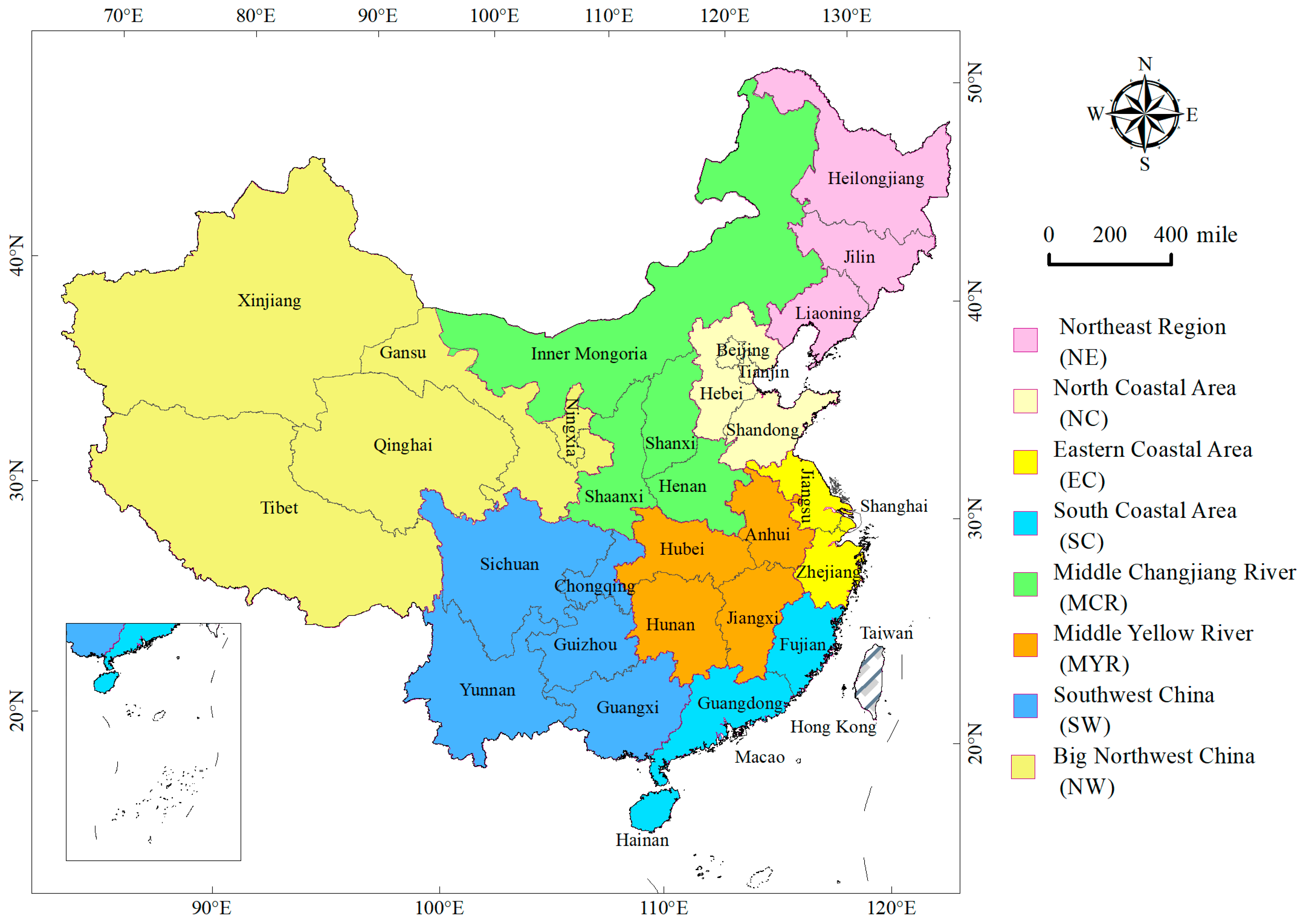

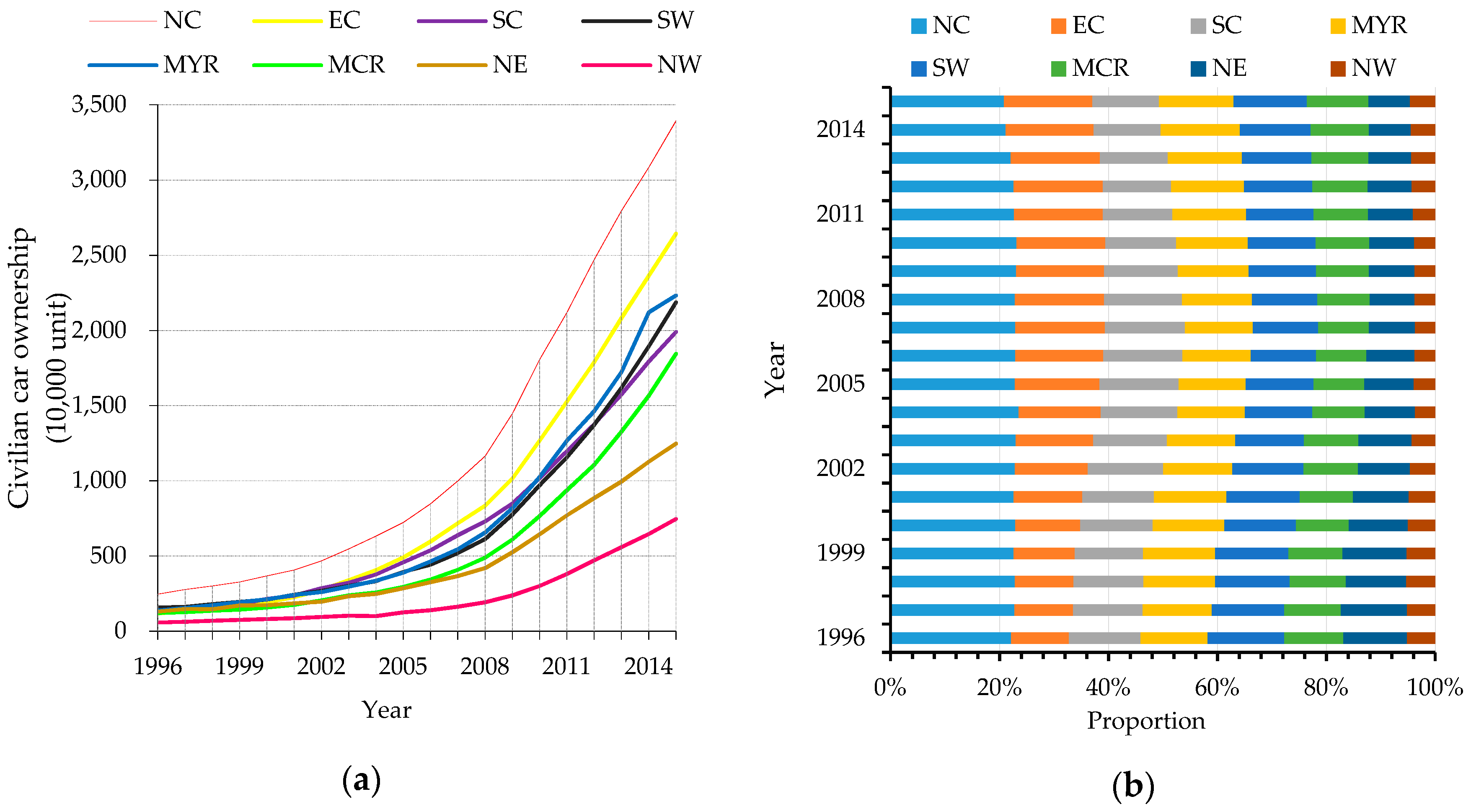
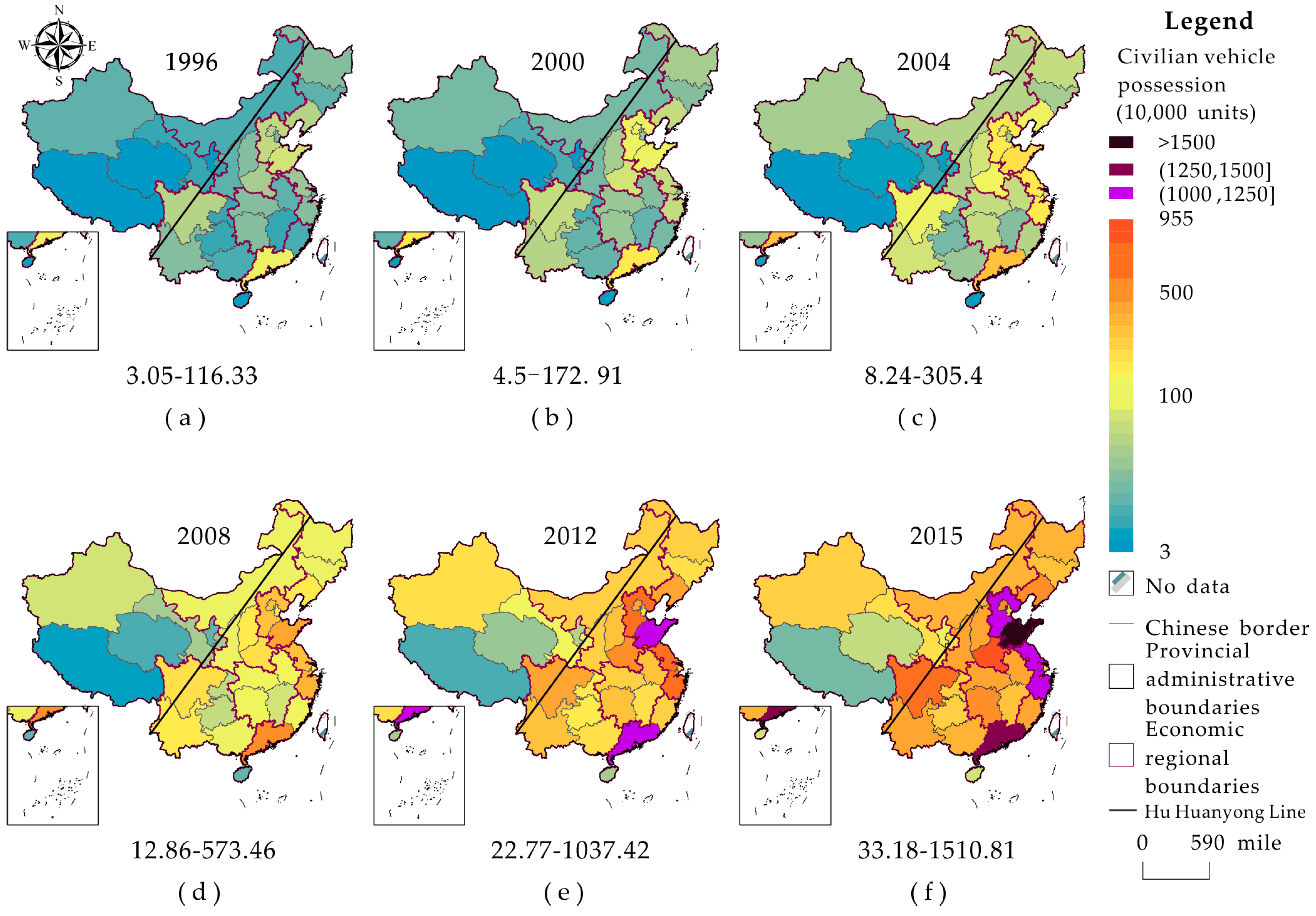


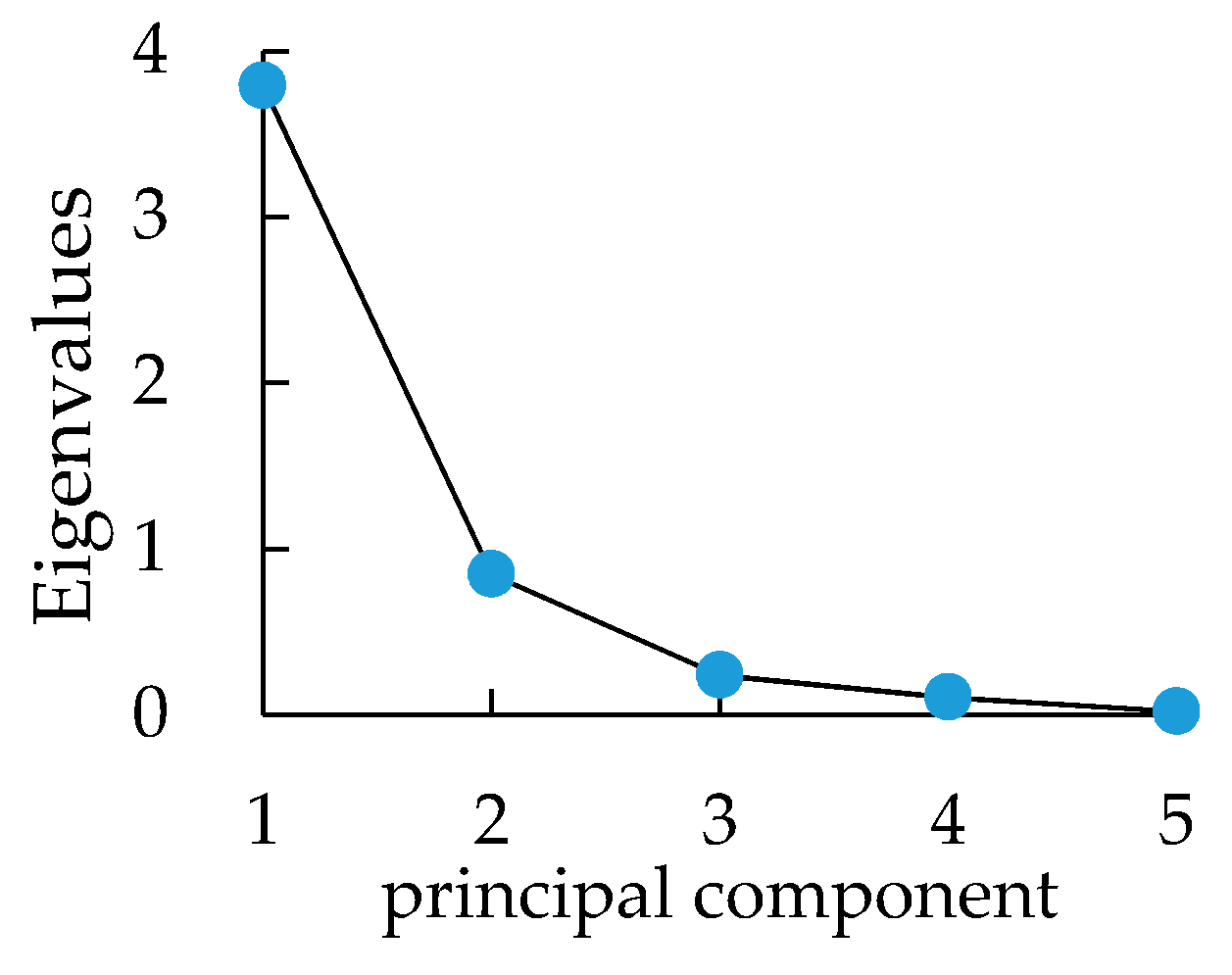
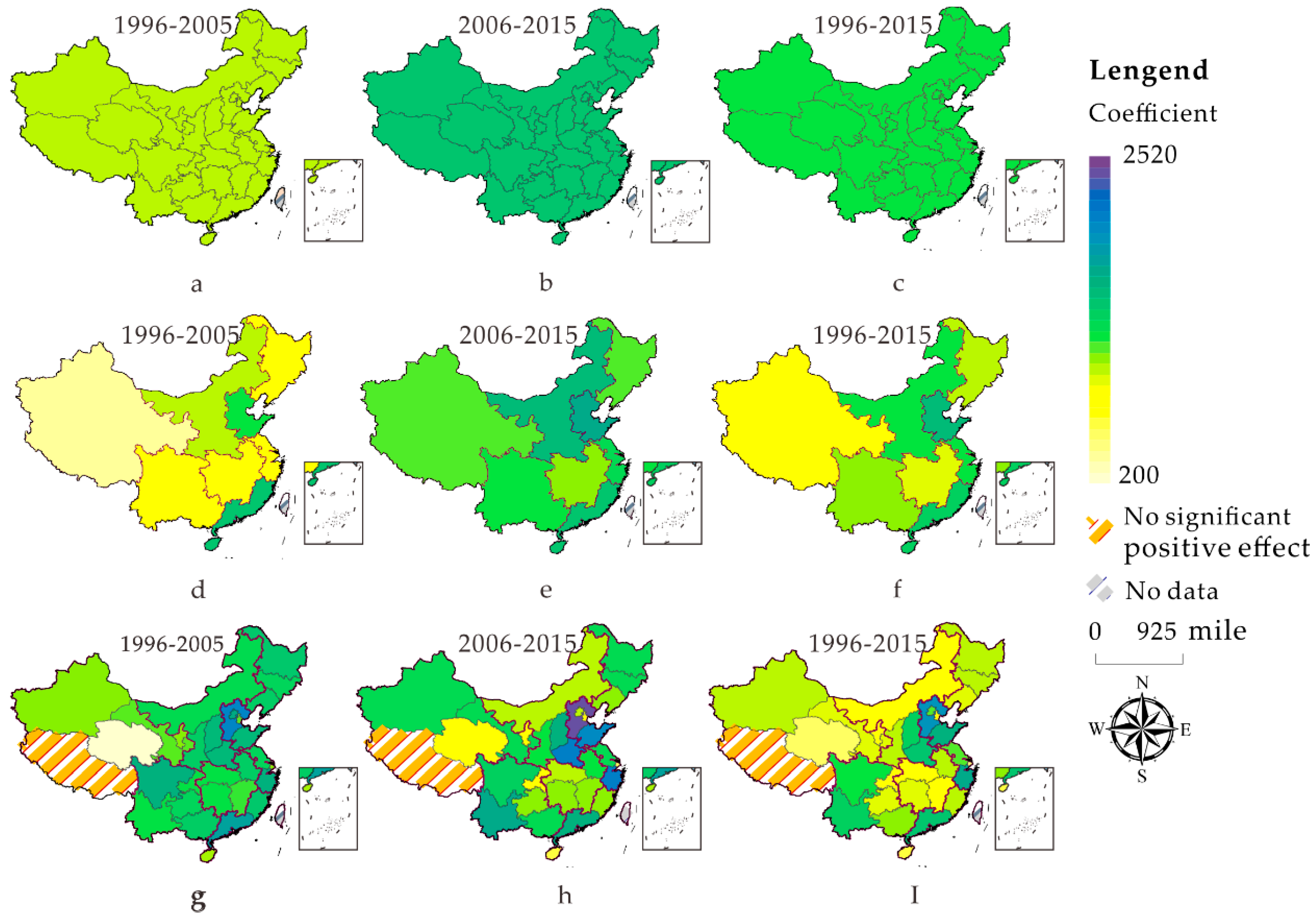
| Zone | Province | Mann-Kendall Test | |
|---|---|---|---|
| Mutation Time | Trends | ||
| 10,000 Unit/a | |||
| NC | Shandong | 2005–2006 *** | 63.25 *** |
| Hebei | 2005–2006 *** | 43.21 *** | |
| Beijing | 2005–2006 *** | 27.65 *** | |
| Tianjing | 2005–2006 *** | 12.65 *** | |
| − | 2005–2006 *** | 151.20 *** | |
| EC | Jiangsu | 2005–2006 *** | 52.60 *** |
| Zhejiang | 2005–2006 *** | 50.79 *** | |
| Shanghai | 2005–2006 *** | 12.42 *** | |
| − | 2005–2006 *** | 115.53 *** | |
| MYR | Henan | 2005–2006 *** | 33.73 *** |
| Shanxi | 2005–2006 *** | 21.52 *** | |
| Shaanxi | 2005–2006 *** | 16.81 *** | |
| Inner Mongolia | 2005–2006 *** | 16.95 *** | |
| − | 2005–2006 *** | 89.26 *** | |
| NW | Xinjiang | 2005–2006 *** | 10.42 *** |
| Gansu | 2006–2007 *** | 7.56 *** | |
| Ningxia | 2005–2006 *** | 3.79 *** | |
| Qinghai | 2006–2007 *** | 2.74 *** | |
| Tibet | 2005–2006 *** | 1.39 *** | |
| − | 2006–2007 *** | 25.81 *** | |
| SC | Guangdong | 2005–2006 *** | 66.83 *** |
| Fujian | 2005–2006 *** | 19.04 *** | |
| Hainan | 2008–2009 *** | 3.20 *** | |
| − | 2005–2006 *** | 88.38 *** | |
| MCR | Anhui | 2005–2006 *** | 18.82 *** |
| Hunan | 2005–2006 *** | 18.32 *** | |
| Hubei | 2005–2006 *** | 17.08 *** | |
| Jiangxi | 2005–2006 *** | 12.34 *** | |
| − | 2005–2006 *** | 65.88 *** | |
| NE | Liaoning | 2006–2007 *** | 23.15 *** |
| Heilongjiang | 2006–2007 *** | 15.16 *** | |
| Jilin | 2005–2006 *** | 12.29 *** | |
| − | 2005–2006 *** | 49.52 *** | |
| SW | Sichuan | 2005–2006 *** | 29.70 *** |
| Yunnan | 2005–2006 *** | 18.72 *** | |
| Guangxi | 2005–2006 *** | 13.49 *** | |
| Guizhou | 2005–2006 *** | 10.27 *** | |
| Chongqing | 2005–2006 *** | 9.87 *** | |
| − | 2005–2006 *** | 80.81 *** | |
| China | − | 2005–2006 ** | 663.83 *** |
| Mean Values | M-K Trend Test of the Tell Indices | 2015 | Contribution Rate M-K Test | |||||
|---|---|---|---|---|---|---|---|---|
| Trends | Statistics | Theil Index | Contribution Rate | Trends | Statistics | |||
| T | 0.0591 | −0.0084 | −4.72 *** | 0.044 | ||||
| Tw | 0.0516 | −0.0025 | −2.92 *** | 0.034 | 57.1% | 0.0247 | 5.35 *** | |
| Tb | 0.1106 | −0.0057 | −5.26 *** | 0.010 | 42.9% | −0.0247 | 3.67 *** | |
| Tk | NE | 0.0104 | 0.0001 | 0.85 | 0.010 | 2.1% | −0.00141 | −2.39 * |
| NC | 0.1432 | −0.0174 | ~5.17 *** | 0.143 | 7.0% | −0.0203 | −5.08 *** | |
| EC | 0.0329 | −0.0040 | ~4.00 *** | 0.033 | 5.9% | 0.000565 | 2.74 *** | |
| SC | 0.0265 | −0.0032 | ~4.81 *** | 0.026 | 1.5% | −0.00232 | −4.18 *** | |
| MYR | 0.0312 | −0.0019 | ~2.56 *** | 0.031 | 3.2% | 0.000419 | 0.85 | |
| MCR | 0.0045 | −0.0006 | ~4.27 *** | 0.005 | 0.4% | −0.00023 | −2.83 *** | |
| NW | 0.0224 | −0.0026 | ~4.90 *** | 0.022 | 1.5% | −0.0015 | −4.45 *** | |
| SW | 0.0527 | −0.0029 | ~4.45 *** | 0.053 | 1.6% | 0.0001 | 0.49 | |
| Variable | PC1 |
|---|---|
| grp | 0.25547 |
| HCL | 0.203776 |
| HM | 0.176927 |
| GDZC | 0.249195 |
| CZSR | 0.252361 |
| Test | LLC | IPS | ADF | PP | |
|---|---|---|---|---|---|
| Time | |||||
| 1996–2005 | car | 24.93 | 20.06 | 1.56 | |
| P’ | 31.06 | 25.45 | 0.48 | ||
| Δcar | 2.37 | 0.67 | 86.26 | ||
| ΔP’ | 3.56 | 4.86 | 42.21 | ||
| ΔΔcar | −18.76 *** | −10.50 *** | 238.55 *** | ||
| ΔΔP’ | −13.36 *** | −6.33 *** | 173.73 *** | ||
| 2006–2015 | car | 1.80 | 16.98 | 18.48 | |
| P’ | 0.24 | 6.79 | 12.66 | ||
| Δcar | 91.33 | −7.48 *** | 0.05 | ||
| ΔP’ | 46.05 | −3.86 *** | 0.51 | ||
| ΔΔcar | 353.13 *** | −10.47 *** | −4.20 *** | ||
| ΔΔP’ | 298.85 *** | −8.20 *** | −5.02 *** | ||
| 1996–2015 | car | 27.88 | 23.32 | 20.18 | |
| P’ | 27.22 | 29.77 | 18.36 | ||
| Δcar | 6.38 | 10.20 | 13.76 | ||
| ΔP’ | −1.05 | 1.91 | 41.75 | ||
| ΔΔcar | −13.93 *** | −14.38 *** | 311.02 *** | ||
| ΔΔP’ | −18.00 *** | −20.20 *** | 441.61 *** | ||
| Test Type | Pedroni | Kao | |||||||
|---|---|---|---|---|---|---|---|---|---|
| Time | Panel v-Statistic | Panel Rho-Statistic | Panel PP-Statistic | Panel ADF-Statistic | Group Rho-Statistic | Group PP-Statistic | Group ADF-Statistic | ADF | |
| 1996–2005 | 3.55 *** | −1.40 ** | −4.99 *** | −7.77 *** | 0.53 | −11.59 *** | −7.13 *** | −1.02 * | |
| 2006–2015 | 4.30 *** | −1.11 | −1.27 ** | −1.97 *** | 2.20 | −0.44 | −3.04 *** | −2.33 *** | |
| 1996–2015 | 0.04 ** | −7.74 *** | −7.36 *** | 2.16 | −2.94 *** | −3.87 *** | 3.72 | 3.72 *** | |
| Time | Eight Economic Regions | Province | National | ||||||||
|---|---|---|---|---|---|---|---|---|---|---|---|
| NE | NC | EC | SC | MCR | MYR | SW | NW | ||||
| 1996–2005 | R2 | 0.98 | 0.95 | 0.92 | 0.99 | 0.96 | 0.96 | 0.97 | 0.96 | 0.99 | 0.96 |
| F test | 91.76 *** | 29.52 *** | 32.28 *** | 175.01 *** | 18.54 *** | 51.70 *** | 77.64 *** | 16.43 ** | 0 | 36.58 *** | |
| Huasman test | 2.63 * | 0.039 | 0.06 | 0.27 | 0.96 | 0.56 | 20.10 | 0.80 | − | 0.38 | |
| Cross-section | ① | ① | ① | ① | ① | ① | ① | ① | ② | ① | |
| Sample size | 30 | 40 | 30 | 30 | 40 | 40 | 50 | 50 | 310 | 310 | |
| 2006–2015 | R2 | 0.93 | 0.94 | 0.94 | 0.99 | 0.98 | 0.93 | 0.96 | 0.96 | 0.99 | 0.96 |
| F test | 31.62 *** | 16.49 *** | 3.52 ** | 70.05 *** | 48.42 *** | 23.94 *** | 26.76 *** | 35.30 *** | 0 | 21.87 *** | |
| Huasman test | 2.76 * | 0.11 | 0.002 | 0.003 | 0.90 | 0.13 | 0.20 | 0.03 | − | 0.30 | |
| Cross-section | ① | ① | ① | ① | ① | ① | ① | ① | ② | ① | |
| Sample size | 30 | 40 | 30 | 30 | 40 | 40 | 50 | 50 | 310 | 310 | |
| 1996–2015 | R2 | 0.95 | 0.94 | 0.91 | 0.98 | 0.96 | 0.92 | 0.93 | 0.94 | 0.98 | 0.93 |
| F test | 0.35 *** | 10.96 *** | 29.44 *** | 49.81 *** | 7.73 *** | 10.78 *** | 8.96 *** | 12.06 *** | 8.53 *** | 17.17 *** | |
| Huasman test | 0.589 | 0.008 | 0.03 | 0.08 | 0.0526 | 0.15 | 7.91 *** | 1.69 | − | 1.20 | |
| Cross-section | ② | ① | ① | ① | ① | ① | ① | ① | ① | ① | |
| Sample size | 60 | 80 | 60 | 60 | 80 | 80 | 100 | 100 | 620 | 620 | |
© 2018 by the authors. Licensee MDPI, Basel, Switzerland. This article is an open access article distributed under the terms and conditions of the Creative Commons Attribution (CC BY) license (http://creativecommons.org/licenses/by/4.0/).
Share and Cite
Yang, K.; Shi, Y.; Luo, Y.; Xia, D.; Zhou, X. The Spatiotemporal Characteristics of Chinese Civil Vehicles’ Possession in the Context of Rapid Economic Development from 1996 to 2015. Sustainability 2018, 10, 2999. https://doi.org/10.3390/su10092999
Yang K, Shi Y, Luo Y, Xia D, Zhou X. The Spatiotemporal Characteristics of Chinese Civil Vehicles’ Possession in the Context of Rapid Economic Development from 1996 to 2015. Sustainability. 2018; 10(9):2999. https://doi.org/10.3390/su10092999
Chicago/Turabian StyleYang, Kun, Yan Shi, Yi Luo, Dian Xia, and Xiaolu Zhou. 2018. "The Spatiotemporal Characteristics of Chinese Civil Vehicles’ Possession in the Context of Rapid Economic Development from 1996 to 2015" Sustainability 10, no. 9: 2999. https://doi.org/10.3390/su10092999
APA StyleYang, K., Shi, Y., Luo, Y., Xia, D., & Zhou, X. (2018). The Spatiotemporal Characteristics of Chinese Civil Vehicles’ Possession in the Context of Rapid Economic Development from 1996 to 2015. Sustainability, 10(9), 2999. https://doi.org/10.3390/su10092999





